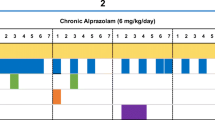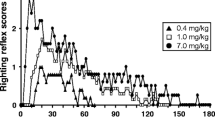Abstract
Forty-nine free-ranging Japanese monkeys (Macaca fuscata) were immobilized with 4.3–15.6 mg/kg (mean±S.D.=10.0±2.5 mg/kg) of ketamine hydrochloride (HCl), and 27 Japanese monkeys kept in enclosures were immobilized with a combination of 0.8–1.4 mg/kg (1.0±0.2 mg/kg) of xylazine HCl and 4.0–7.1 mg/kg (5.0±0.6 mg/kg) of ketamine HCl. In the xylazine HCl-ketamine HCl combination, good myorelaxation was induced. The mean induction times for the single dosage of ketamine HCl and the xylazine HCl-ketamine HCl combination were 2.8±1.5 min and 6.9±4.4 min, respectively. The mean immobilization times with the single dosage of ketamine HCl and the xylazine HCl-ketamine HCl combination were 39.3±16.5 min and 58.8±34.2 min, respectively. A half dose of ketamine HCl in combination with xylazine HCl could also immobilize Japanese monkeys successfully. Administrations of 0.5 mg/kg i.v. and 1.0 mg/kg i.m. of yohimbine HCl as an antagonist to xylazine HCl at 30 min after the induction reduced the immobilization time to 31.4±0.5 min and 49.0±22.1 min, respectively. Yohimbine HCl appears to be an effective antagonist to combination anesthesia by xylazine HCl-ketamine HCl in the Japanese monkey.
Similar content being viewed by others
References
Banknieder, A. R., J. M. Phillips, K. T. Jackson, &S. I. Vinal, Jr., 1978. Comparison of ketamine with the combination of ketamine and xylazine for effective anesthesia in the rhesus monkey (Macaca mulatta).Lab. Anim. Sci., 28: 742–745.
Hatch, R. S., N. H. Booth, J. D. Clark, L. M. Crawford, J. V. Kitzman, &B. Wallner, 1982. Antagonism of xylazine sedation in dogs by 4-aminopyridine and yohimbine.Amer. J. Vet. Res., 44: 417–423.
Jessup, D. A., W. E. Clark, P. A. Gullett, &K. R. Jones, 1983. Immobilization of mule deer with ketamine and xylazine, and reversal of immobilization with yohimbine.J. Amer. Vet. Med. Ass., 183: 1339–1340.
Kitzman, J. V., N. H. Booth, R. C. Hatch, &B. Wallner, 1982. Antagonism of xylazine sedation by 4-aminopyridine and yohimbine in cattle.Amer. J. Vet. Res., 43: 2165–2169.
Mech, L. D., G. D. del Giudice, P. D. Karns, &U. S. Seal, 1985. Yohimbine hydrochloride as an antagonist to xylazine hydrochloride-ketamine hydrochloride immobilization of white-tailed deer.J. Wild. Diss., 21: 405–410.
Ramsay, M. A., I. Stirling, L. O. Knutsen, &E. Broughton, 1985. Use of yohimbine hydrochloride to reverse immobilization of polar bears by ketamine hydrochloride and xylazine hydrochloride.J. Wild. Diss., 21: 396–400.
White, G. L. &J. F. Cummings, 1979. A comparison of ketamine and ketamine-xylazine in the baboon.Vet. Med. Small Anim. Clin., 74: 392–396.
Author information
Authors and Affiliations
About this article
Cite this article
Hayama, Si., Terazawa, F., Suzuki, M. et al. Immobilization with a single dose of ketamine hydrochloride and a combination of xylazine hydrochloride-ketamine hydrochloride and antagonism by yohimbine hydrochloride in the Japanese monkey (Macaca fuscata). Primates 30, 75–79 (1989). https://doi.org/10.1007/BF02381212
Received:
Accepted:
Issue Date:
DOI: https://doi.org/10.1007/BF02381212




